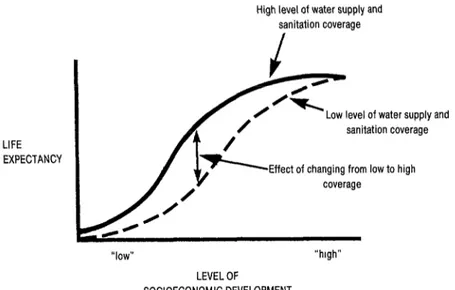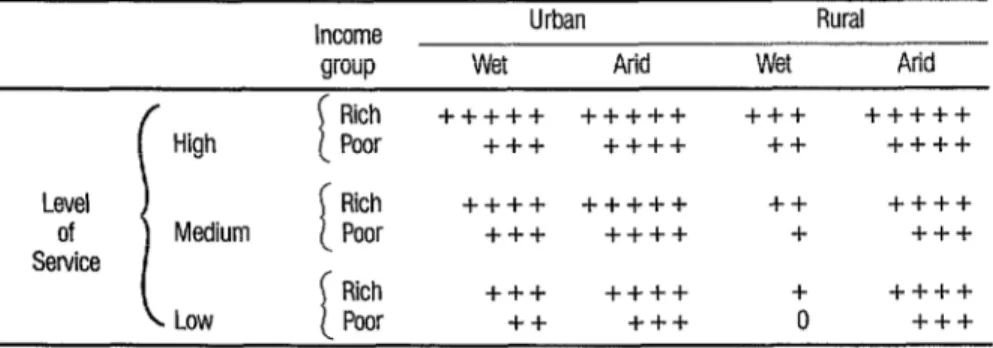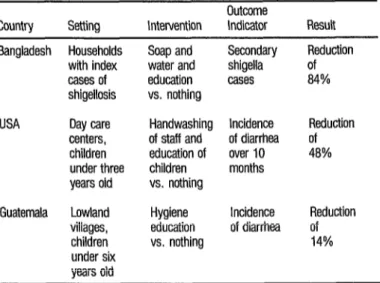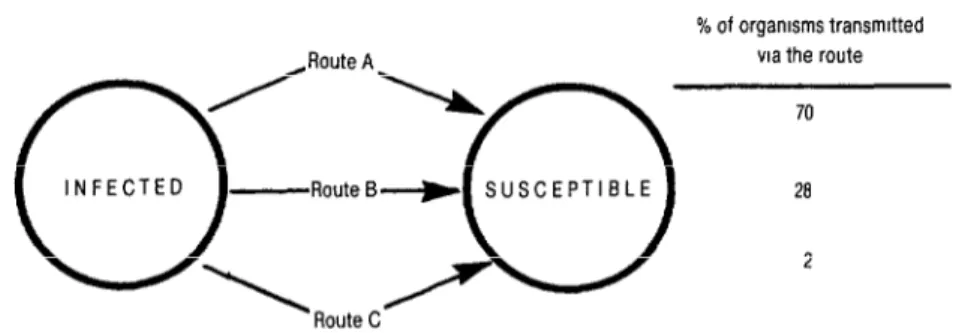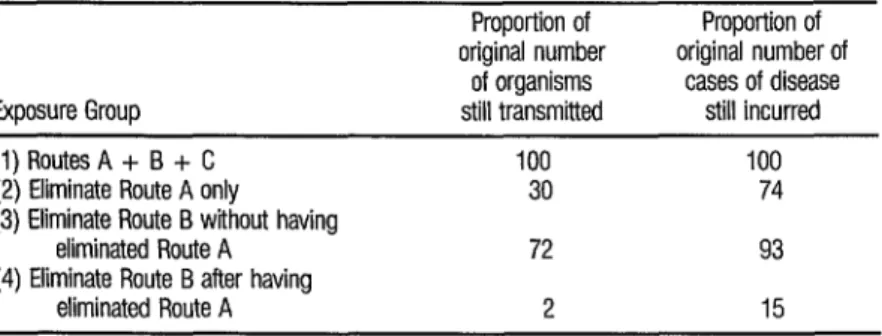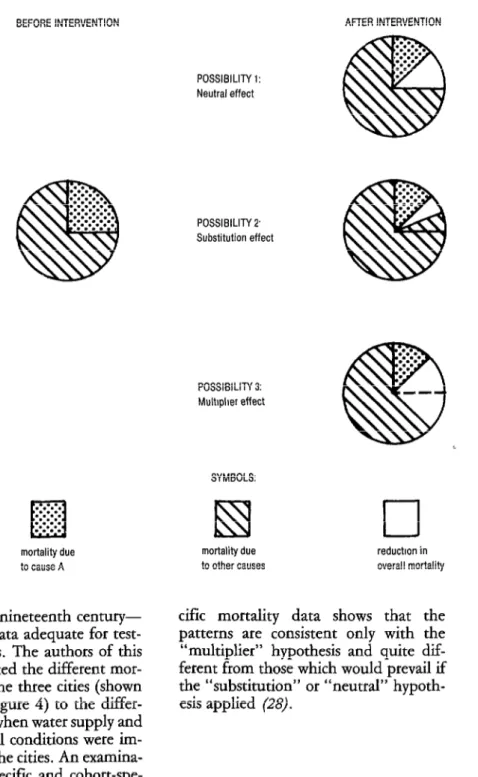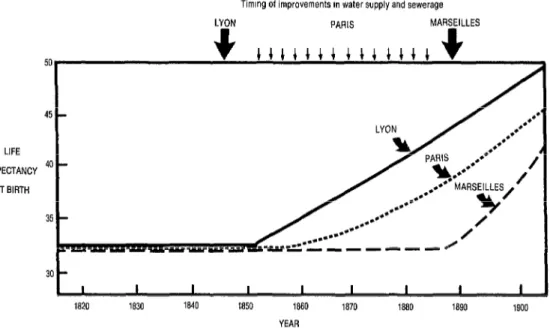A
ROLE
FOR WAmR SUPPIY AND SANITATION IN
THE CHILD SURVIVAL REVOLUTION’
B
ACKGROUND
Improvements in water sup- ply and sanitation conditions played a fundamental role in improving health in industrialized countries during the nine- teenth century (1). In the mid-1970s it was generally agreed that water supply and sanitation had a similar role to play in the transition to low mortality rates in developing countries. As a consequence of this belief, water supply and sanita- tion were included as integral parts of the
primary health care (PHC) package (Z),
and the 1980s were declared to be the United Nations’ International Drinking Water Supply and Sanitation Decade.
Upon closer examination of
the PHC strategy, it was argued in an in-
fluential policy-oriented analysis (3) that insufficient resources were available to
implement the complete package of PHC
interventions, and that only those inter- ventions which were most cost-effective in terms of reducing infant mortality should be implemented. In particular, it was argued that the cost per infant death averted through water supply and sanita-
’ This article will also be published in Spanish in the Bo- Letin de /a OfGina Sanitaria Pana9neticana, volume
l&i, 1988.
* Associate Professor, School of Public Health, University of North Carolina, Chapel Hill, North Carolina; and Water and Urban Department, World Bank, Washing- ton, D.C., USA.
tion programs was much higher than the cost per infant death averted through a selective primary health care package that included oral rehydration therapy,
DFT and measles immunizations, malaria
treatment, and breast-feeding.
A second influential policy- oriented analysis (4) made a national- level comparison of life expectancy among countries with low and high wa- ter supply and sanitation coverage. As in-
dicated in Figure 1, this study suggested
that at both low and high levels of socio- economic development improvements in water supply and sanitation conditions would have relatively little effect on
health, and that it was in the “middle- level” countries that the effect would be greatest.
As a result of these analyses, the de facto policy of several interna- tional agencies has been that water sup- ply and sanitation interventions may oc- casionally be appropriate at relatively
advanced stages of the development pro- & 2
cess, but that they are not cost-effective -
at the earlier stages where other interven- s
tions such as immunizations, oral rehy- ;;;
dration, and family planning are be- .g
lieved more sensible. Thus, for instance,
in the Asia Region USAID may give con-
3
sideration to a water supply program in 5 a,
FIGURE 1. Refationship between level of socioeconomic development, level of wafer supply and sanitation service, and Iii expectancy (affer Walsh and Warren--b).
High level of water supply and sanitation coverage
LIFE EXPECTANCY
Low level of water supply and sanitation coverage
coverage
“low”
LEVEL OF
SOCIOECONOMIC DEVELOPMENT
Thailand (a middle-level country) but not in Bangladesh (a poor country).
Over the past couple of years,
with leadership from UNICEF, strong sup-
port has developed for the “child sur-
vival revolution” (5). Because of the
belief that they do not constitute cost- effective health interventions, water sup- ply and sanitation have been assigned a lower priority in this effort than have biochemical actions such as oral rehydra- tion therapy and immunizations. For in- stance, in a US congressional bill autho- rizing the Child Survival Fund, water supply programs were not included among the child survival activities that could be funded (G).
It is the thesis of this paper that this relegation of water supply and sanitation projects to a lower priority level is incorrect. It is argued that the methodology whereby priorities are es-
“high”
tablished is systematically biased against systemic interventions such as water sup- ply, that the direct effects of such inter- ventions are generally underestimated, and that the indirect and long-term ef- fects on health (which are presently ig-
nored) appear to be substantial.
T
HE EFFECTS
OF WATER
SUPPLY
AND SANIIXI’ION
ON HEALTH
The Multiple Impacts of Water and Sanitation Programs
as water supply and sanitation) that af- fect not only child survival but also a set of other health outcomes (including childhood morbidity as well as morbidity and mortality in other age groups) and a variety of nonhealth (social, economic, and political) outcomes.
To deal with water supply and sanitation programs in this framework, it is necessary to undertake two supple- mentary analyses so that such programs may be fairly compared with other health sector programs. First, it is neces- sary to partition the total costs of water supply and sanitation interventions into those costs that can be attributed to non- health benefits and those (the remain- ing) costs that can be attributed to health
benefits. Second, it is necessary to ex-
press the set of health outcomes in terms of a common denominator such as “equivalent child deaths.”
With regard to the partition- ing of costs, it has been argued (8) that under normal circumstances the willing- ness of consumers to pay for a service is a measure of the nonhealth benefits, and therefore that the cost attributable to health is the difference between total costs and willingness to pay. Where tar- iffs are set correctly and where user
charges are made, this difference will be
the cost that is met through use of public funds. For example, as Table 1 indicates in the case of Lima, Peru (3), if a piped water supply were installed in areas pres-
ently served by water vendors, the full costs of such a supply would be borne by the consumers.
In this particular instance, all the costs would be borne by private pay- ments; and in many other cases only a small proportion of the total costs have to be borne by public funds. To make this
“cost partitioning” concept useful for
planners, the key requirement is it-&or- mation on the willingness of consumers to pay for water supply and sanitation services in different settings. From evalu- ations of water supply projects, it is ap-
parent that willingness to pay for an im-
proved supply is greater where water is supplied to the house rather than to a
communal facility (10, 1 I), and in arid
rather than wet areas (traditional sup- plies often being considered satisfactory
in the latter areas-12, 13, 14), and
among high-income rather than low-
income people (10, 12, 15, 16). From
these and other unpublished data, it would appear that the willingness to pay for water supply and sanitation services is as shown in %bles 2 and 3.
If the estimates on Tables 2 and 3 are even roughly correct, they im- ply that substantial private payments can be expected for water supplies in most
TABLE 1. Cost of watar to consumers who are SeNed and not SeNed by piped
water in Lima, Peru (8).
Not served by piped system Served by piped system
Quantity of water used (liters per capita per day)
Monthly expenditure (1972 soles per household
per month)
TABLE 2. Anticipated willingness to pay (as a proportion of household income) for wafer senrices in different social and natural settings. In this fable “ + + + + + ” indicates a very high willingness to pay and I‘ + ” or “0” indicates a very low willingness ta pay.
Income arouo
Urban Rural
Wet Arid Wet Arid
i
Rich +++-I-+ +++++ +++ +++++
High Poor +-t-+ ++++ ++ ++++
Level Rich ++-I-+ +++++ ++ ++++
of Medium i Poor +++ ++++ + +++
Service
Rich +++ ++++ + ++++
Low Poor ++ +++ 0 +++
TABLE 3. Anticipated willingness to pay (as a proportion of household income) for sanitation senrices in different social and natural settings. In this fable “ + + + + + ” indicafes a very high willingness fo pay and “ + ” or “0” indicates a very low willingness to pay.
Income group
Urban Rural
Wet Arid Wet Arid
Rich +++++ ++4++ +++ +++++
High Poor +++ ++++ ++ ++++
Level Rich ++++ ++i-++ ++ ++++
of Medium i Poor +++ ++++ + +++
Service
Rich +++ ++++ + ++++
Low Poor ++ +++ 0 +++
unserved urban areas (generally low-in- come areas); for any adequate water sup- plies in arid rural areas; for water piped to yard taps in rural areas where abun- dant water is available; and for basic san- itation services in urban areas. Thus the implication is that in these settings the costs to be borne from public sources would be lowest; and, ceterirparibzls, in
these instances interventions are more likely to be cost-effective.
The second requirement in developing a correct estimate of “cost per infant death averted” for water supply
and sanitation interventions is a method of expressing the full range of morbidity and mortality reductions produced by such programs in terms of “equivalent infant deaths.” An analogous problem has been addressed by a United States In- stitute of Medicine study on setting pri-
orities for vaccine development (17).
Through an iterative procedure, a panel of public health experts agreed on the “infant mortality equivalents” for reduc- tions of morbidity and reductions of mortality in all age groups.
mortality but also morbidity and mortal- ity in other age groups, whatever the weighting emerging from such a proce- dure, the “equivalent child deaths” for water supply and sanitation will be
greater than the “equivalent child
deaths” for a targeted intervention with an identical effect on child mortality alone. Furthermore, it can be assumed that this difference would be substantial in developing countries, where economic welfare is dependent on productive adults, and where heavy emphasis should be given to reducing morbidity and mortality among adults (18).
Typical Short-run Impacts on Child Survival
At the start of the Interna- tional Drinking Water Supply and Sani- tation Decade it was implicitly claimed that diseases among children in develop- ing countries would be reduced by 80% if water supply and sanitation conditions improved. Probably because of the exag- gerated nature of such claims, the pen- dulum has now swung to a point where it is often claimed that water supply and sanitation programs have little effect on health. In the original Selective Primary Health Care calculations, for instance, it was assumed that improved water supply and sanitation conditions would reduce d&heal diseases by just 5 % . A recent, authoritative study for the Diarrheal Dis- eases Control Program of the World
Health Organization (19) has shown that
water supply and sanitation programs typically have large impacts on diarrhea1 disease morbidity (Table 4), and even larger impacts on d&heal disease mor- tality.
If water supply and sanitation programs are to have an impact on health, it is necessary not only that water supply and sanitation facilities be con- structed and that they function ade- quately, but also that these facilities be used appropriately. As it has become evi- dent that serious problems are frequently encountered with the use of improved facilities, more attention has been given to the hygiene education component of water supply and sanitation programs. In many cases hygiene education programs have been shown to have little impact on actual hygiene practices (20). In three in- stances summarized on Table 5 (Zl), only one of which involved a community setting, the impact of intensive hygiene education interventions on the incidence of diarrhea has been measured.
From Table 5 it appears that where personal hygiene practices can be improved through hygiene education programs, such interventions may have a substantial impact on diarrhea. (It
TABLE 4. Impact of water supply and sanitation interventions on diarrhea1 disease morbidity (after Esrey et al.- 79).
Median % reduction in Improvement in: Number of studies diarrhea1 disease morbidity
Water quality 9 18%
Water quantity 17 25%
Water qualii
and quantii
a
37%TABLE 5. Effect of hygiene education programs on diarrhea1 disease (after Feachem-27).
Countrv Settina Intervention
Outcome
Indicator Result
Bangladesh Households Soap and with index water and
cases of education
shigellosis vs. nothing
USA Day care
centers, children under three years old
Handwashing of staff and education of children vs. nothing
Guatemala Lowland villages, children under six years old
Hygiene education vs. nothing
Secondary shigella cases
Incidence of diarrhea over IO months
Incidence of diarrhea
Reduction of 84%
Reduction of 48%
Reduction of 14%
should be noted that in many settings improvements in personal hygiene can- not take place without prior improve- ments in water availability.)
While global figures on costs and benefits are useful for getting a pre- liminary sense of which programs might be cost-effective, in fact both the bene- fits and the costs of water supply and san- itation and other health-related pro- grams vary greatly with local social, economic, natural, and epidemiologic conditions. It is thus essential to develop locally applicable data bases on both the costs and the impacts of different inter- ventions. In the specific case of water supply and sanitation, the critical infor- mation needed relates to the impact of the level of service (such as water distrib- uted through standpipes, through a yard tap, or through house taps) and the in- teractions between water supply, excreta disposal, and hygiene education pro-
grams. Unfortunately the methodologic tools available for evaluating the health impacts of such interventions in specific settings are such that these evaluations are extremely expensive, take years to complete (22), and are often methodo- logically flawed (23). While recent work (24) offers some hope that valid and rapid epidemiologic assessment tech- niques may be applicable in this area, these methods are only now being field tested. Although initial experiences (2s) are positive, at the present time health impact evaluations cannot be recom- mended for most water supply and sani- tation projects, and planners have to draw on the global data base-suitably modified by an understanding of the specific local epidemiologic situation.
Necessary but Insufficient Interventions
questions that need to be addressed be- fore drawing conclusions about the over- all health impact of a proposed project. First, as is done in this section, it is essen- tial to consider the possibility that an im- provement may be a necessary but not
sufficient condition for improving
health; and second, as is done in the next section, it is necessary to understand the relationship between the project’s imme- diate effects (which are generally mea- sured in impact evaluations) and the project’s longer-term effects.
For a water supply improve- ment to have an impact on a fecal-oral disease (such as a d&heal disease) it is necessary that the number of organisms ingested be reduced and also that this re- duction translate into reduced disease. We will therefore briefly repeat an argu- ment produced in more detail elsewhere
(26), which shows that under conditions of poor overall sanitation, major reduc- tions in exposure may translate into only small reductions in disease.
Consider the simple model
shown in Figure 2, where there are three
parallel routes by which organisms can be transmitted from one person to an- other. For the most common (log-linear) type of dose-response relationship, it can be shown, as in ‘Ikble 6, that elimination of just one transmission route (even the major transmission route) has little im-
pact on disease. Table 6 also shows that elimination of the major transmission route is nevertheless of great importance in reducing disease, since it is only after this apparently ineffective intervention has been undertaken that subsequent in- terventions (reducing transmission via the other routes) can be effective. In the simple example given in Table 6, the elimination of Route A alone only re- duces disease incidence by about one- quarter. However, the importance of eliminating Route A is not this modest direct effect, but rather the fact that its elimination creates conditions that allow subsequent interventions to be much more effective. In the example given, if only Route B were eliminated this would have little impact on disease transmis- sion; whereas if Route B were eliminated after the elimination of Route A, this would have a major impact.
2
Simple as it is, this model k
captures some essential features of the
real world in which water supply and san- 2
itation interventions operate, and thus Q *
has important implications for assessing 3
the impact of such interventions. In the many parts of the developing world
where there are several parallel routes for 2 -
$ R E
2 9 s FIGURE 2. Multiple routes for the transmission of fecal-oral pathogens.
TABLE 6. An example of the effect of eliminating different routes on disease incidence (see Rgure 2).
Exposure Group
(1) Routes A + B + C (2) Eliminate Route A only (3) Eliminate Route B without having
eliminated Route A (4) Eliminate Route B after having
eliminated Route A
Proportion of Proportion of original number original number of
of organisms cases of disease still transmitted still incurred
100 100
30 74
72 93
2 15
effectively transmitting fecaloral patho- gens, it is quite possible that improve- ments in, say, water supply would have little direct impact on health and yet would still constitute important health interventions. In other words, in these circumstances such improvements are a necessary but not a sufficient condition for substantial disease reduction. As dis- cussed in more detail elsewhere (2~9, available empirical evidence (including that presented in Figure 1) suggests that this phenomenon is operative in many of the poorer parts of the developing world. Under such conditions, care needs to be exercised before concluding that a water supply or sanitation program was not a
justified health intervention because
there was little direct impact on disease.
The Relationship of Short-run and Long-run Impacts
While the objective of child survival programs is (obviously) to reduce child mortality, these interventions are usually evaluated by assessing the impact on morbidity or mortality due to a partic- ular disease. In most such analyses it is assumed that if disease A accounts for
30% of the deaths, and if the interven- tion reduces deaths due to disease A by 50%, then there will be an overall reduc- tion in mortality of 15 % ( = 30% x 50%).
As illustrated on Figure 3, however, there are three distinct ways in which such specific interventions may re- late to overall changes in child mortality.
A key question in assessing the overall impact of a particular health intervention is whether this type of inter- vention is one for which the “neutral,”
“substitution,” or “multiplier” effect is
operative. Because so few studies testing these hypotheses have been carried out, and because the effect of specific inter- ventions will certainly be different in dif- ferent settings, any general conclusions must be regarded as extremely tentative. The few relevant studies that are avail- able suggest that measles immunizations may save lives that would be lost not only to measles but also to other causes (that
is, the “multiplier” effect is operative),
while for oral rehydration therapy in Bangladesh, at least, children whose lives are “saved” may not return to normal mortality risks (that is, the “substitu- tion” effect is operative-27).
FIGURE 3. Possible impacts upon overall mortality of an intervention reducing mortalii due to a specific disease (‘kause A”) by 50%.
CAUSES AND LEVEL OF MORTALITY:
BEFORE INTERVENTION
. .-.-.
. . .
El
l .*:.* . . . .. . . . . . .
mortality due to cause A
ban France in the nineteenth century-
1) that furnishes data adequate for test-
ing this hypothesis. The authors of this study have attributed the different mor- tality patterns in the three cities (shown schematically in Figure 4) to the differ- ences in the dates when water supply and wastewater disposal conditions were im- proved in each of the cities. An examina- tion of the age-specific and cohort-spe-
POSSIBILITY 1: Neutral effect
POSSIBILITY 2 Substitution effect
AFTER INTERVENTION
POSSIBILITY 3: Mult~pher effect
SYMBOLS:
mortality due reduction in to other causes overall mortality
cific mortality data shows that the
patterns are consistent only with the
“multiplier” hypothesis and quite dif-
ferent from those which would prevail if
the “substitution” or “neutral” hypoth-
FIGURE 4. Mortalt declines in urban France in the nineteenth century (atter Preston and van de Walle- 7).
Timmg of improvements m water supply and sewerage
LIFE
EXPECTANCY
AT BIRTH 50
1820 1830 1840 1850 1860 1870 1880 1890 1900
YEAR
Unfortunately, no other simi- larly rich data sets exist for contemporary developing countries. Although, as with other interventions, the effect of water
supply and sanitation interventions
would be different in different settings, from the single adequate set of data it appears that water supply and sanitation interventions have a multiplier effect on mortality. The effect of this multiplier ef- fect is illustrated in Table 7, which shows the long-run mortality effects of the ac-
TABLE 7. The effect of different interventions on short-term and long-term mortality (after Btfscoe-29).
Intervention type (%): Impact Impact
None Type A Type B of B I of A
Deaths averted in youngest age group: (a) In initial E-year period (b) In fourth 15year period
Life expectancy of cohort’ (a) born in the first period following intervention:
(i) Assuming that age-specific mortality rates have stabilized 15 years after the intervention (ii) Using true mortality rates experienced by the cohort (b) born in the last (4th) 15year period, assuming that mortality rates have stabilized
15.5 15.5 1.00
15.5 62.4 4.03
100.0 102.7 103.7 1.37
100.0 102.7 105.4 2.00
tual environmental improvement (Type B) as compared to the effects of another hypothetical intervention (Type A) that would have had the same impact on mortality in the youngest age group in the first period, but which had no in- creased impact over time and which did not affect the mortality experience of the older age groups.
As is evident from Table 7 (and a more detailed discussion else-
where-29) by not considering whether
the effect of a particular program is likely
to have a “neutral,” “substitution,” or
“multiplier” effect, the impact of those
programs that have a “multiplier” effect
(such as, tentatively, measles vaccination and water supply and sanitation pro- grams) may be seriously underestimated; and the impact of those programs that
have a “substitution” effect (such as,
tentatively, oral rehydration therapy pro- grams) may be seriously overestimated.
C
ONCLUSIONSThe current strategy for the “Child Survival Revolution” gives low priority to improvements in water supply and sanitation, because it has been con- cluded that these interventions are not cost-effective. The point of this article is that this conclusion is incorrect for the following reasons :
0 Because water supply and san-
itation projects have multiple impacts, care needs to be exercised in applying
conventional cost-effectiveness tech-
niques to such projects.
0 Because adequate water sup-
ply and sanitation facilities are necessary but not sufficient conditions for im- provements in health, the provision of improved facilities may be essential for improving health (by reducing exposure
to fecal-oral pathogens) even though this does not have a large, immediate impact on health status.
a The long-run effect on child
survival resulting from improved water supply and sanitation conditions is prob- ably substantially greater than would be expected on the basis of an assessment of the immediate effects on diarrheal dis- ease.
l In addition, a review of the
immediate impact of water supply and sanitation projects on morbidity due to diarrheal diseases shows that these im- pacts are usually substantial.
From this perspective, it would appear that there are serious flaws in the analytic methods being used to de- cide on priorities for child survival activi- ties, and that water supply and sanitation improvements (and other broad-based interventions) have a major role to play in the “Child Survival Revolution.”
A
CKNOVVZEDGMIENTSThe material presented in this article is based on a presentation made to a USAID-convened Expert Panel on Water Supply and Sanitation in Child Survival that was funded by the Water and Sani- tation for Health (WASH) Project. The comments of the four other panelists (Robert Black, Alexander Langmuir, Henry Mosley, and David de Ferranti) and the Director of the Office of Health at USAID (Kenneth Ban) are appreciated.
s
UMMARY
It has been argued that invest- ments in water supply and sanitation should not be a major element of pri- mary health care because these are not cost-effective health investments. This article demonstrates that the methodol- ogy used to arrive at this conclusion is sys- tematically biased against water supply and sanitation; that such investments may be important for health even if the direct effects are modest; that the long run effects are substantially greater than the short-run effects; and that, these fac- tors notwithstanding, the short-run im- pacts of water supply and sanitation improvements on health are usually sub- stantial.
RE
FERENCES
Preston, S. H., and E. Van de Walle. Urban French mortality in the nineteenth century. Population Studies 32(2):275-297, 1978.
World Health Organization. Alma-Ata 1978: Primary Health Care; Report of the Intema-
tional Conference on Primary Health Care, Alma-Ata, USSR, 6-12 September 1978. Ge- neva, 1978.
Walsh, J. A., and K. S. Warren. Selective pri- mary health care: An interim strategy for de-
veloping countries. N Eq$ J Med
301(18):967-974, 1979.
Shuval, H. I., R. L. Tilden, B. H. Perry, and R. N. Grosse. Effect of investments in water supply and sanitation on health status: A threshold-saturation theory. Bull WHO
59(2):243-248, 1981.
United Nations Children’s Fund. State of the I&Xz”s Chi&.&en, 198s. Oxford University Press, Oxford, 1985, 131 pp.
United States Congress, Committee on For- eign Relations and Committee on
fairs. Legislation on Foreign
1984. Section 4 on “Child Survival Fun Washington, D.C., 1985, p. 23.
United States Agency for International Devel- opment. AID Sector Strategy: Health. Wash- ington, D.C., 1984, 8 pp.
8 Briscoe, J. Water Supply and Sanitation in the HeaIth Sector in the Asia Region: Information Needs and Program Priorities. Document pre- pared for the Near East and Asia Bureau of
USAID. United States Agency for International
Development, Washington, D.C., 1985, 46 PP.
9 Adrianza, B. T., and G. G. Graham. The high cost of beine noor: Water. Arch Environ
10
11
12
13
14
15
Health 28:31?-$15, 1974.
Dworkin, D. M., and B. L. K. Pillsbury. The Potable Rural Water Project in Rural Thail;znd.
USAID Project Impact Evaluation Number 3. United States Agency for International Devel- opment, Washington, D.C., 1980.
Cooper and Lybrand Associates. Egypt Provin- ctil Water Supply Project: Report on a Survey
of Consumers’ Attitudes to Potable Water. World Bank, Washington, D.C., 1979,60 pp.
Chetwind, E., and D. M. Dworkin. Korea Po- table Water Systems Project: Lessons from Ex-
perience. USAID Project Impact Evaluation
Number 20. United States Agency for Interna- tional Development, Washington, D.C., 1981.
Haratani, J., A. M. Viveros-Long, and A. M. B. M. Gonzales. Peru: CARE OPG Water Health Services Project. USAID Project Impact Evaluation Number 24. United States Agency for International Development, Washington, D.C., 1981.
Bigelow, R. E., and L. Chiles. Tunisia: CARE Water Projects. USAID Project Impact Evalua- tion Number 10. United States Agency for In- ternational Development, Washington, D.C., 1980.
Dworkin. D. M. Kenva Rural I&ter Subbk: Program;, Progress, aid Prospects. USAID‘hij-
ect Imnact Evaluation Number 5. Washine- ton, D:C., 1980.
17
18
19
20
21
22
23
Institute of Medicine. New Vfcine Develop- ment: Estab/sbin~ Priorities: Volume I: Dis- easer of Importake in thhe United Stater. Washington, D.C., 1985, pp. 17-27.
Chen, L. C. Control of d&heal diseases mor- bidity and mortality: Some strategic issues. Am J Ckn Nutr 31:2284-2286, 1978.
Esrey, S. A., R. G. Feachem, and J. M. Hughes. Interventions for the control of diar- rhoeal diseases among young children: Im- proving water supplies and excreta disposal fa- cilities. Bull WHO 63(4):757-772, 1985.
Atiz, K. M. A., K. 2. Hasan, K. M. S. Azit, and M. M. Rahaman. Behavioural Changes in Water Use Following Health Education in a Rural Area of Bangladesh. In: International Center for D&heal Disease Research. Pro- ceedings of the Second Arian Conference on DiarrhoeaL Disease. Dhaka,
desh, 1983. Bangla-
Feachem, R. G. Interventions for the control of diarrhoeal disease among young children: Promotion of personal and domestic hygiene. Bull WHO 62(3):467-476, 1984.
World Bank. Measurement of the Health Ben- efits of Investments in Water Supply. Report of an Expert Panel, PUN Report No. 21. World Bank, Washington, D.C., 1976, 12 pp.
Blum, D., and R. G. Feachem. Measuring the impact of water supply and sanitation i&est- ments on diarrhoeal diseases: Problems of f;;th;c$ogy. Int J EpidemioL 12(3):357-
1 .
24
25
Briscoe, J., R. G. Feachem, and M. M. Raha- man. Measuring the Impact of Water Su ply and Sanitation Facilities on Diarrhoea Mor Id- fi. ity: Prospects for Case-Control Methods. Mim- eographed documents ~~01cws185.3 and CDDl OPRl85.1. World Health Organiza- tion, Division of Environmental Health and Diarrhoeal Diseases Control Programme. Ge- neva, 1985, 71 pp.
Young, B. A., and J. Briscoe. Health Impact Evaluation of the Malawi Rural Water Supply: A Case-Control Study of Diarrhea. Report to
USAID and the Government of Malawi. United States Agency for International Development. Lilongwe, 1986.
26 Briscoe, J. Intervention studies and the defmi- tion of dominant transmission routes. Am J Epia’emio/120(3):449-455, 1984.
27 Mosley, W. H. Child survival: Research and policy. In: W. H. Mosley and L. C. Chen (eds.). Child survival: Strategies for research.
PopuZation and Development Review
lO(suppl):3-22, 1984.
28 United States Agency for International Devel- opment. Water Supply and Sanitation in Child Survival: A Report to and Discussion by an Expert Panel. Washington, D.C., 1985, 26 pp.
29 Briscoe, J. Evaluating water supply and other Q health
talky e i! rograms: Short-run vs. long-run mor- ti ects. Public Health (London) 99: 142- 8 145, 1985.
